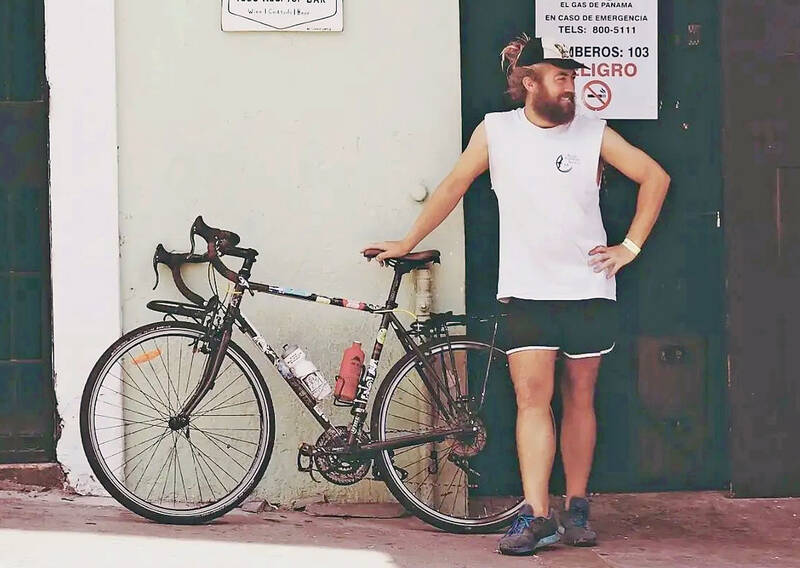It’s hard to know where to begin with Mark Tovell’s Taiwan: Roads Above the Clouds. Having published a travelogue myself, as well as having contributed to several guidebooks, at first glance Tovell’s book appears to inhabit a middle ground — the kind of hard-to-sell nowheresville publishers detest.
Leaf through the pages and you’ll find them suffuse with the purple prose best associated with travel literature: “When the sun is low on a warm, clear morning, and with the heat already rising, we stand at the riverside bike path leading south from Sanxia’s old cobble streets.” Hardly the stuff of your typical Lonely Planet or Rough Guide. Yet this kind of diary entry is followed by maps, alluring photographs of mountain roads and instructions detailing how to get from point A to point B without missing a scenic bridge or roadside bathroom.
There is, in the introduction, the caveat that “we don’t recommend specific hotels or hostels, and we don’t rate or grade restaurants or attractions.” But such information would doubtlessly be useful to a first-time cyclist in a country where English-fluency remains limited, especially in the rural uplands that are the principle subject of the book. The justification that “There is no wrong choice in Taiwan,” applies to the limited F&B listings as it does to what equipment you’ll likely need, but again, some hard advice might be warranted here — what kind of terrain am I up against and what tools will I need beyond the obvious “puncture repair kit with tire levers?”

However, for certain details, such as the road categorization system used in Taiwan, or where you might be able to pitch a tent for the night — apparently the lawns of “temples, churches and schools” are good — the information provided is helpful, alluding to both on-the-ground experience and serious research.
Once you get through a few chapters of Tovell’s book and acquaint yourself with its home-made style, the value of Taiwan: Roads Above the Clouds surfaces like a buoy released from the seabed. This is a very specific book, one aimed directly at the class of traveler that unboxes their velo at the airport (not Taoyuan’s, where cycling is prohibited, although Kaohsiung International is fine) and pedals directly towards the high hills. And after reading a few chapters more, you’ll want to do just that.
BETWEEN THE LINES

Photo courtesy of Mark Tovell
Self-published by addoil, Taiwan: Roads Above the Clouds rides above its imperfections to offer something unique to the travel book market — an indispensable companion to anyone that is keen to cycle beyond the flatlands promoted by the government as the must-ride Cycling Route No.1 (自行車環島1號線). In fact, the author argues that “the country’s first official cycle route, skips, avoids and straight up ignores some of Taiwan’s highlights and best areas.”
Cycle Route No.1 doesn’t even appear in the book. Instead, the alternatives are advanced. The first three chapters essentially guide a reader/cyclist through the island’s craggy interior along Taiwan’s “spine” through Nantou County and down to the southwest, a region that, as the author notes, “has one of the highest densities of high mountains anywhere in the world…”
Detailing day-long bike rides from little known places like Lishan (梨山) and Renai (仁愛), the reader rolls vicariously through “Blue-hued mountains” that “stretch off in the distance, nearby peaks and their lush green caps contrast with a clear blue sky.” The fact that you can actually follow this route via a map, comprehensive road notes and hand-drawn sketches is where the book’s genius lies — it takes you off-the-beaten-path as a cerebral traveler then challenges you to go there yourself. The second half of the book guides readers around Taiwan’s “tail” — the Hengchun Peninsula — where you’re invited to “glide around hidden ocean roads and camp by the island’s best surf, sunbathing and palm tree spots” with excursions to outlying island like Siaoliouciou Island (小琉球) and Orchid Island (Lanyu, 蘭嶼島) also included.

Photo courtesy of Mark Tovell
Returning north, again Tovell’s book highlights an alternative to the classic round-island (環島) route that is a rite-of-passage for so many Lycra-clad cyclists, recommending instead, the East Rift Valley between Taitung and Hualien as a scenic ride.
HYBRID PUBLISHING
At almost 300 pages, the book might seem like something of a dinosaur in our compact, digital age. However, Tovell has linked the analogue book to cyberspace via an easy-to-navigate website from where you can purchase a compact “touring edition” of the book, a PDF e-book as well as posters and route maps, the latter of which can also be accessed via QR codes included in the book.
Taiwan: Roads Above the Clouds then, is more than just a bicycle touring guide. In some ways, notwithstanding its digital appendages, the book recalls an age of publishing past, when Victorian adventures would produce works that were part diary, part anthropological investigation, and would include illustrations and maps for readers at home — a far cry from the formulaic world of publishing in our time.
What truly distinguishes Tovell’s book, however, is the care, time and love the Tainan-based author (who also designed the book) has clearly put into this passion project. Sure, he has ignored certain expectations of the book market, deliberately omitting routes or details he considers uninteresting. The book is unashamedly niche and deeply personal. Yet the core of the book, namely how to cycle “roads above the clouds” through a “stunning, complex and often misunderstood island” is covered with infectious zeal and the rigor of a cycling aficionado.
As the blurb on the back cover has it, this is a “love letter to Formosa” made by one that knows its heartlands.

Taiwanese chip-making giant Taiwan Semiconductor Manufacturing Co (TSMC) plans to invest a whopping US$100 billion in the US, after US President Donald Trump threatened to slap tariffs on overseas-made chips. TSMC is the world’s biggest maker of the critical technology that has become the lifeblood of the global economy. This week’s announcement takes the total amount TSMC has pledged to invest in the US to US$165 billion, which the company says is the “largest single foreign direct investment in US history.” It follows Trump’s accusations that Taiwan stole the US chip industry and his threats to impose tariffs of up to 100 percent

On a hillside overlooking Taichung are the remains of a village that never was. Half-formed houses abandoned by investors are slowly succumbing to the elements. Empty, save for the occasional explorer. Taiwan is full of these places. Factories, malls, hospitals, amusement parks, breweries, housing — all facing an unplanned but inevitable obsolescence. Urbex, short for urban exploration, is the practice of exploring and often photographing abandoned and derelict buildings. Many urban explorers choose not to disclose the locations of the sites, as a way of preserving the structures and preventing vandalism or looting. For artist and professor at NTNU and Taipei

March 10 to March 16 Although it failed to become popular, March of the Black Cats (烏貓進行曲) was the first Taiwanese record to have “pop song” printed on the label. Released in March 1929 under Eagle Records, a subsidiary of the Japanese-owned Columbia Records, the Hoklo (commonly known as Taiwanese) lyrics followed the traditional seven characters per verse of Taiwanese opera, but the instrumentation was Western, performed by Eagle’s in-house orchestra. The singer was entertainer Chiu-chan (秋蟾). In fact, a cover of a Xiamen folk song by Chiu-chan released around the same time, Plum Widow Missing Her Husband (雪梅思君), enjoyed more

From insomniacs to party-goers, doting couples, tired paramedics and Johannesburg’s golden youth, The Pantry, a petrol station doubling as a gourmet deli, has become unmissable on the nightlife scene of South Africa’s biggest city. Open 24 hours a day, the establishment which opened three years ago is a haven for revelers looking for a midnight snack to sober up after the bars and nightclubs close at 2am or 5am. “Believe me, we see it all here,” sighs a cashier. Before the curtains open on Johannesburg’s infamous party scene, the evening gets off to a gentle start. On a Friday at around 6pm,